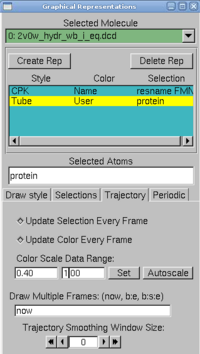Team:EPF-Lausanne/Analysis methods
From 2009.igem.org
| Line 1: | Line 1: | ||
{{EPF-Lausanne09}} | {{EPF-Lausanne09}} | ||
<div CLASS="epfltrick">__TOC__ | <div CLASS="epfltrick">__TOC__ | ||
| - | </div><div CLASS=" | + | </div><div CLASS="epfl09model"> |
Revision as of 17:45, 20 October 2009




Information needed
Generating input files
In this section, we explain all the steps to create needed files for namd, except the .conf file. We need a compatible .pdb in addition to parameter and topology files to go through. Steps to generate all the input files are explained in detail on this page How to generate input files. This is a kind of summary of the tuto.
Launch a simulation
We start from .pdb, .psf, .rtf generated in the previous sections and we explain how to launch NAMD on both clusters we have access to. Complete process is on a separate page How to launch a simulation.
Namd .conf parameters
Namd can run different kind of simulations, from minimization to MD simulations. Here are the .conf file we used. NamdConf
Scripts used
We stored all our scripts, which were highly modified compared to the original ones, in order to fit our needs. You can find them on this page.
Step by step analysis
The following section is a kind of tutorial, which describes step by step how to obtain our different results.
This analysis will check whether the minimization, the heating and the equilibration took place correctly and whether the protein did not explode.
Maxwell-Boltzmann Energy DistributionHere we will confirm that the kinetic energy distribution of the atoms in a system corresponds to the Maxwell distribution for a given temperature. |
|---|
EnergiesHere we will calculate the average of various energies such as kinetic energy and different internal ones so called bonded energies (bonds, angles and dihedrals). Moreover, we will calculate non-bonded energy (electrostatic, van der Waals)) over the course of the equilibration. |
|---|
Temperature distributionHere we will analyze the temperature distribution over the simulation. The temperature might increase linearly during the heating step and then it might remain stable. We obtained the expected results.
|
|---|
DensityHere we will analyze the behavior of the protein density over the simulation. Normally during the equilibration step density might remain more or less stable. Particularly during the NVT equilibration the density might remain constant. We obtained the expected results. |
|---|
Pressure as a function of simulation timeHere we will analyze the pressure behavior along the minimization and the equilibration. This quantity might stabilize after the heating and remain more or less stable during the equilibration. Particularly during the NPT steps the pressure might be strictly constant. We obtained the expected results. |
|---|
RMSD for individual residuesHere we will calculate the RMSD for each residue to determine which residue move the most. This analysis will help us to see which residue is more or less stable. After that we will try after that to select the amino acids to mutate in order to stabilize the light activated state of our LOV domain.
|
|---|
RMSD of selected atoms compared to initial position along timeHere we will analyze the RMSD of each atom to check whether the protein remains more or less stable during the equilibration. We obtained the expected results.
|
|---|
Salt bridgesSalt bridges are non-bonded interactions between charged residues. Here we will analyze the evolution of these interactions over the equilibration in order to check how these interactions change over the equilibration. |
|---|
RMSFThis is quite similar to the RMSD analysis. Here we will analyze how the RMSF vary for each residues. |
|---|
AnglesThis part is made to measure the angle between two chains. The procedure is described below.
|
|---|
H bonds and distance measurmentsThis part aim at finding characteristic distances, in particular for H-bonds. |
|---|
Dihedral anglesDihedral angles measure angle between four atoms.
|
|---|
 "
"







